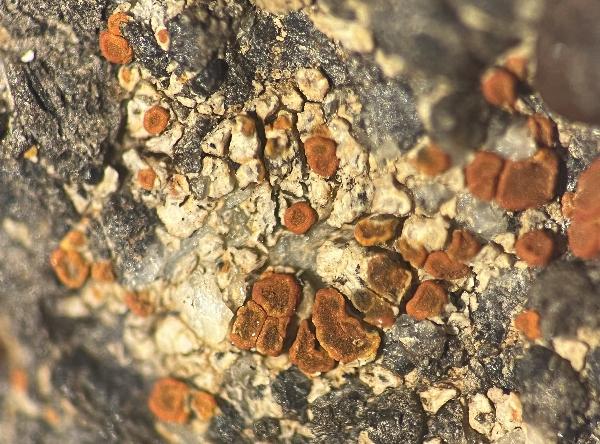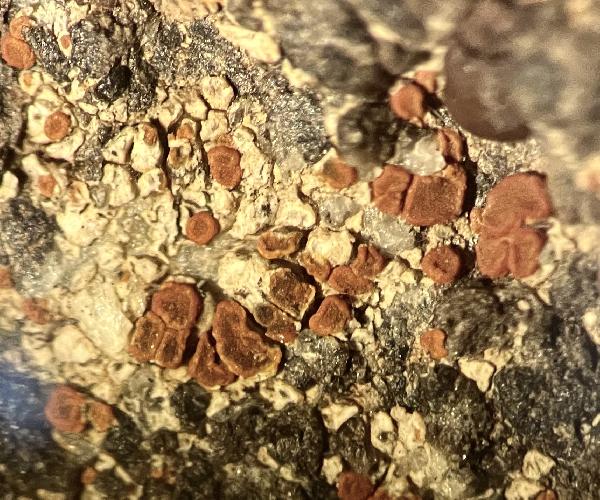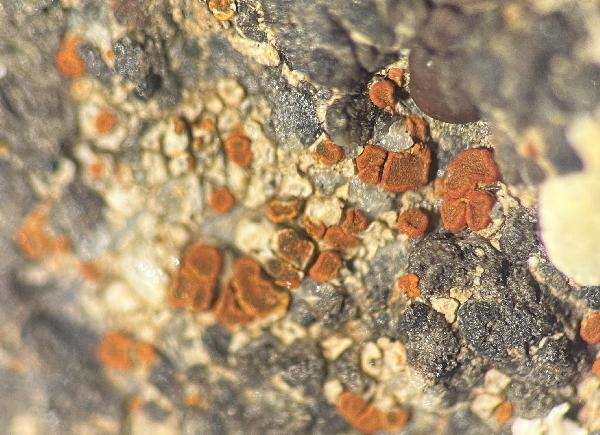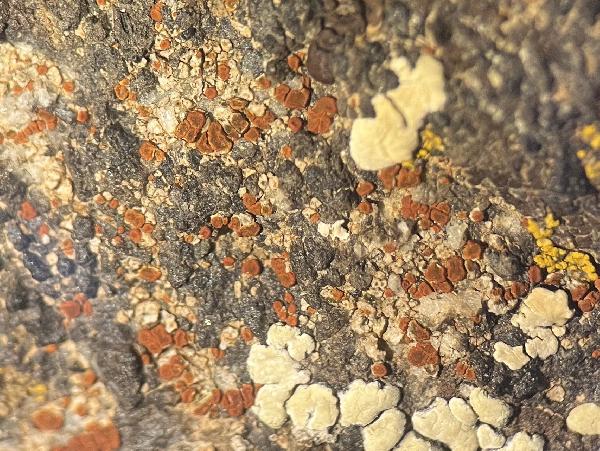Rufoplaca rubroaurantiaca (B. de Lesd.) Cl. Roux
Bull. Ass. Fr. Lichénologie, 47, 1: 30, 2022. Basionym: Caloplaca rubroaurantiaca B. de Lesd. - Bull. Soc. Bot. France, 97: 169, 1950.
Synonyms:
Distribution: N - Piem (Morisi & Sereno 1995, Morisi 2005), VA (Matteucci & al. 2012, 2013, 2015, Sandrone 2014), Lig (Loppi & al. 1997).
Description: Thallus crustose, thinly episubstratic, whitish grey, often poorly visible. Apothecia cryptolecanorine to zeorine, sessile, irregularly rounded, 0.2-0.7 mm across, with an orange-red, flat to slightly convex disc, a concolorous or paler, raised proper margin, and a thalline margin which is usually developed only at the base of the apothecium and is soon excluded. Epithecium yellowish brown, inspersed with granules, 10-15 µm thick, K+ purple-red; hymenium colourless 55-85 µm high, sometimes inspersed with a few oil droplets, I+ blue; paraphyses mostly simple; hypothecium colourless, 25-50 µm high, sometimes inspersed with a few oil droplets. Asci 8-spored, clavate, functionally unitunicate, apically thickened with a broad internal beak, the inner part of apex and external cap I+ blue, Teloschistes-type. Ascospores 2-celled, polarilocular, hyaline, narrowly ellipsoid, 9-14 x 3-4(-6) µm, the equatorial thickening (“septum”) short, 1-2 µm. Photobiont chlorococcoid. Spot tests: thallus K-, C-, KC-, P-; apothecia K+ purple-red. Chemistry: thallus probably without lichen substances or with the Sedifolia-grey pigment; apothecia with an unknown set of non-chlorinated anthraquinones.Note: a poorly known silicicolous species, a member of the difficult Rufoplaca arenaria-group characterised by the smaller spores with a thinner septum, known only from Italy, Switzerland and the French Alps (Dauphinè). The record from Valle d'Aosta (see Nimis 1993: 182) requires confirmation.
Growth form: Crustose
Substrata: rocks
Photobiont: green algae other than Trentepohlia
Reproductive strategy: mainly sexual
Poorly known taxon in need of further study
Commonnes-rarity: (info)
Alpine belt: absent
Subalpine belt: very rare
Oromediterranean belt: absent
Montane belt: very rare
Submediterranean belt: very rare
Padanian area: absent
Humid submediterranean belt: very rare
Humid mediterranean belt: very rare
Dry mediterranean belt: absent

Predictive model
Herbarium samples
Growth form: Crustose
Substrata: rocks
Photobiont: green algae other than Trentepohlia
Reproductive strategy: mainly sexual
Poorly known taxon in need of further study
Commonnes-rarity: (info)
Alpine belt: absent
Subalpine belt: very rare
Oromediterranean belt: absent
Montane belt: very rare
Submediterranean belt: very rare
Padanian area: absent
Humid submediterranean belt: very rare
Humid mediterranean belt: very rare
Dry mediterranean belt: absent

Predictive model
| Herbarium samples |
 INDEX FUNGORUM
INDEX FUNGORUM
 GBIF
GBIF






